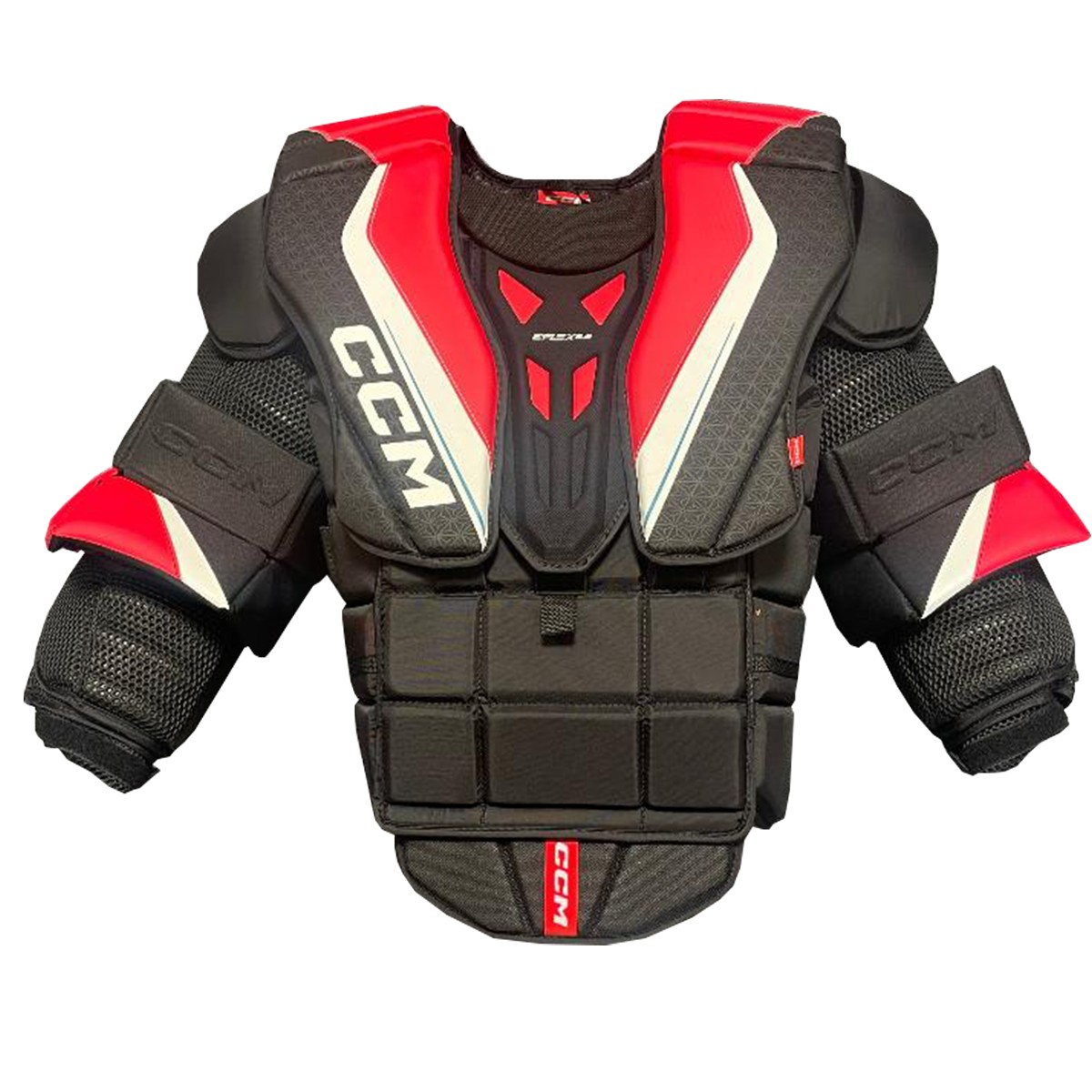
Original price was: $329.99.$197.95Current price is: $197.95.
We strive to provide the ultimate shopping experience for goalies seeking the best in gear, prices, and service. Our extensive expertise in the goalie gear industry, spanning over 20 years, allows us to offer unparalleled customer service and expert advice. Whether you're a seasoned pro or new to the game, our knowledgeable team is dedicated to helping you find the perfect gear to match your needs. Don't hesitate to reach out to us with any questions.
Please note: all prices are in US dollar.
CCM Extreme Flex E6.9 Intermediate Chest & Arm Protector
New for 2023 is the CCM Extreme Flex 6.9 goalie chest & arm protector. CCM made a huge emphasis on fit and ventilation for 2023. The new Extreme Flex 6.9 chest protector has the Aer-Tec Ventilation System. This system is built with perforated foams that allow for more breathability in the chest area of the goalie’s body. This system is also on the back/spine area of the chest protector. Combining the airflow on the front the unit and the back of the unit will allow the goalie to stay cooler and hopefully more productive during the course of a practice or game.
The Xtreme Flex 6.9 is still a very mobile unit with a lot of adjustable features. The arms, shoulder floaters, collar area can all be adjusted for a customized for every goalie. Compared to the CCM Axis Chest & Arm Protector, the CCM Extreme Flex 6.9 is a streamlined design that is more mobile than the Axis design. The Axis is the bigger/bulkier design for goalies that want to take up more net coverage while the Extreme Flex is for the goalie that wants more mobility.
Chest Protector Style – Athletic Hybrid Style
CCM Extreme Flex E6.9 Chest Protector Features:
-
- Model Year: 2023
- Max Flex Fit: Built for ultimate mobility.
- Air Flow: Aer-Tec Ventilation System – Mobile design with added breathability.
- Back & Spine: Aer-Tec Ventilation System – Optimal airflow and breathability on the back of the goalie.
- Sternum & Clavicle: Molded HD Foam – Great impact protection.
- Shoulder Wings: Quick Release Velcro Adjustment with Flex Motion Design – Customized fit that moves with you.
- Elbow Protection: Independently Adjustable Elbow Protection with Comfort Fit Cap – Personized fit for mobility.
- Rib Protection: Multi Segmented HD/LD Ventilated Foam – Extended impact protection & coverage with added breathability.
- Chest Protection: Multi Segmented HD/LD Ventilated Foam – Optimized protection that keeps you mobile.
- Bicep/Forearm Protection: Compression-Molded HD Foam – Superior protection and mobility.
- Shoulder Cap: Compression-Molded HD Foam – Optimized protection
Athletic Style (Hybrid) Vs. Blocking Style (Coverage) Chest Protectors
There are two basic designs in the goalie market in regard to chest protectors. These are based on the two types of styles that goalies play – hybrid and coverage. The hybrid goalie needs a more athletic style chest protector that allows him/her to move freely and maximize their agility. These units contour around the body with little to no gaps. The shoulder floaters are also smaller and form around the goalie in a more natural manner. Arms and elbow guards move freely and do not bind up, allowing for maximum mobility. The big upside to having an athletic style chest protector is the movement and freedom these provide. The downside to the athletic style chest is a decrease in size and materials. Now we are not saying they are not protective because most chest protectors are built to a very high standard and have great protection qualities. However, to make something move better you have to take something away and by doing this there will obviously be less material. We can say honestly that athletic chest protectors are extremely protective and the added materials in the blocking style are more about taking up space then adding protection.
The blocking style chest protectors are built for the coverage goalies that like to play big and take up as much space in the net as possible. The shoulder floaters are much wider and usually have multiple layers. The arm and elbow guards are also flared wider to take up as much space as possible. The blocking style chest protector tends to have more gaps and extra space on the goalie’s body because of the extra size. The upside to the blocking style chest protectors is the extra space it takes up. These chest protectors can easily make the shoulder width of a goalie four to six inches wider compared to an athletic style chest protector. Also, since the arms and elbow are bigger, there are less gaps for the puck to squeeze between the goalie’s body and arms. The downside to these blocking style units is the lack of movement. Because of the extra bulk, movement can be compromised. You can’t have the best of both worlds, if you make it bigger it will take away mobility.

